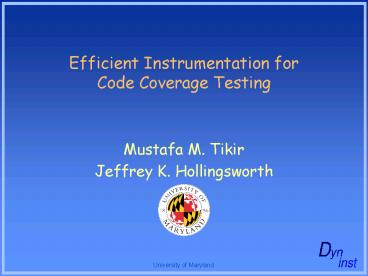Efficient Instrumentation for Code Coverage Testing - PowerPoint PPT Presentation
1 / 19
Title:
Efficient Instrumentation for Code Coverage Testing
Description:
especially for long running programs such as servers and enterprise software ... Transfers machine code to a running mutatee program ... – PowerPoint PPT presentation
Number of Views:172
Avg rating:3.0/5.0
Title: Efficient Instrumentation for Code Coverage Testing
1
Efficient Instrumentation forCode Coverage
Testing
- Mustafa M. Tikir
- Jeffrey K. Hollingsworth
2
Evaluation of Code Coverage
- Measuring code coverage is important to
- Identify unexecuted program statements
- Verify that each path is taken at least once
- Requires extensive instrumentation
- Must determine if every statement is executed
3
Instrumentation for Code Coverage
- Traditional Approach
- Static instrumentation using counters
- Instrumentation code remains for entire execution
- Conservative instrumentation of all possibly
needed instrumentation code for all functions - Useless instrumentation wastes time
- especially for long running programs such as
servers and enterprise software - Full instrumentation increases setup time
4
Our Approach
- Insert instrumentation code dynamically
- Pre-Instrument all functions at program start
- On-Demand instrument at first function call
- Periodically remove instrumentation
- Use dominator trees
- Reduces instrumentation within a function
- Use incremental function instrumentation
- Insertion of instrumentation on first call
- Reduced which function gets instrumented
5
Dyninst API
- Modify code in a running program
- Implementations available for
- Alpha,Sparc,Power,Mips and x86 architectures
- A mutator program
- Generates machine code from high-level code
- Transfers machine code to a running mutatee
program
Base Tramp
Mini Tramp
Program
- Mutatee is the application being instrumented
- Base-trampoline contains
- relocated instructions
- slots for calling code
- Mini-trampoline stores the inserted code
Save Registers
Pre
Setup Args
Relocated Instruction
Code Snippet
Restore Registers
Post
6
Using Dominator Trees
- Definitions
- A dom B if all paths from entry to basic block B
goes through basic block A - A idom B if, for all C, (C ! A) and (C dom B)
implies (C dom A) - Fact
- If a basic block, B, is executed
- all basic blocks along the path from B to the
root of dominator tree also execute
7
Leaf Node Instrumentation
- Leaf nodes in dominator tree are instrumented
- Coverage of internal nodes will be inferred
- Coverage information propagated from leaf nodes
to entry
Dominator Tree
Control Flow Graph
Entry
Entry
1
1
3
2
3
2
5
4
4
5
Exit
Exit
8
Non-Leaf Node Instrumentation
- Leaf node instrumentation is necessary but not
sufficient - Control flow might cause cross edges in dominator
tree
Control Flow Graph
Dominator Tree
Entry
Entry
2
1
1
3
2
3
Exit
Exit
- We also instrument basic block, A, if
- A has at least one outgoing edge to basic block,
B, and - A does not dominate B
9
Code Coverage Algorithm
Pre-Instrumentation
On-Demand Instrumentation
- At Start
- Create CFG and dominator trees for all functions
- Instrument the basic blocks selected
- During Execution
- Stop the execution at fixed time intervals
- Delete the executed instrumentation code
- At Termination
- Propagate and collect the coverage information
- At Start
- Insert breakpoints at each function entry
- During Execution
- On breakpoint
- Identify the function
- Create CFG and dominator tree
- Instrument the basic blocks selected
- At fixed time intervals delete the executed code
- At Termination
- Propagate and collect the coverage information
10
Reduction In Instrumentation Points
- 34-49 with pre-instrumentation
- 42-79 with on-demand instrumentation
11
SPEC/compress Coverage Curve
- Covers 76 in the first 18 of the execution
- Most of the basic blocks that will execute are
covered at the beginning of the program - Rest of the run is re-executions
12
SPEC/compress Execution Time
- Purecov is a commercial state of art code
coverage tool - Our code coverage tools outperform purecov
- Significant reduction when dynamic code deletion
is enabled - Most of the instrumentation code is deleted at
the beginning - Setup time and deletion overhead is insignificant
- A few number of basic blocks to instrument and
check
13
PostgreSQL Coverage Curve
- Wisconsin benchmark queries
- Measure the performance of database systems
- Executes select/join queries repeatedly
14
PostgreSQL Execution Time
Execution Time
Setup, Instrumentation and Deletion Time
- Using on-demand instrumentation
- Our coverage tools outperform purecov almost
always - On-demand instrumentation outperforms
pre-instrumentation
15
Instrumentation Execution Frequency
- Overhead of our dynamic code coverage system is
bursty - Running previously unexecuted code results in the
execution of a significant amount of
instrumentation - Running previously executed code does not result
in the execution of any instrumentation
16
Overall Slowdown
- Results for our code coverage tool are for
2-second deletion - Slowdown using purecov ranges from 1.83 to 19.78
- Slowdown using our code coverage tools range
- From 1.002 to 2.6 for on-demand instrumentation
- From 1.002 to 4.96 for pre-instrumentation
17
Dyninst Coverage Tool
18
Conclusions
- Dominator trees
- Reduce instrumentation points by 34-49
- Plus on-demand instrumentation reduce
instrumentation points by 42-79 - Combining dominator trees and on-demand
instrumentation reduces - Setup time and deletion interval overhead
- Runtime overhead by 38-90 compared to purecov
- Dynamic deletion of instrumentation
- Computes coverage information faster
19
Conclusions (cont)
- Code Coverage overhead reduced to about 10
- Code coverage can now be included as part of
production code - Information about the execution of extremely
infrequent error cases will be provided - Reduced overhead for residual testing
- Dyninst library Dyninst Coverage tools
- http//www.dyninst.org































